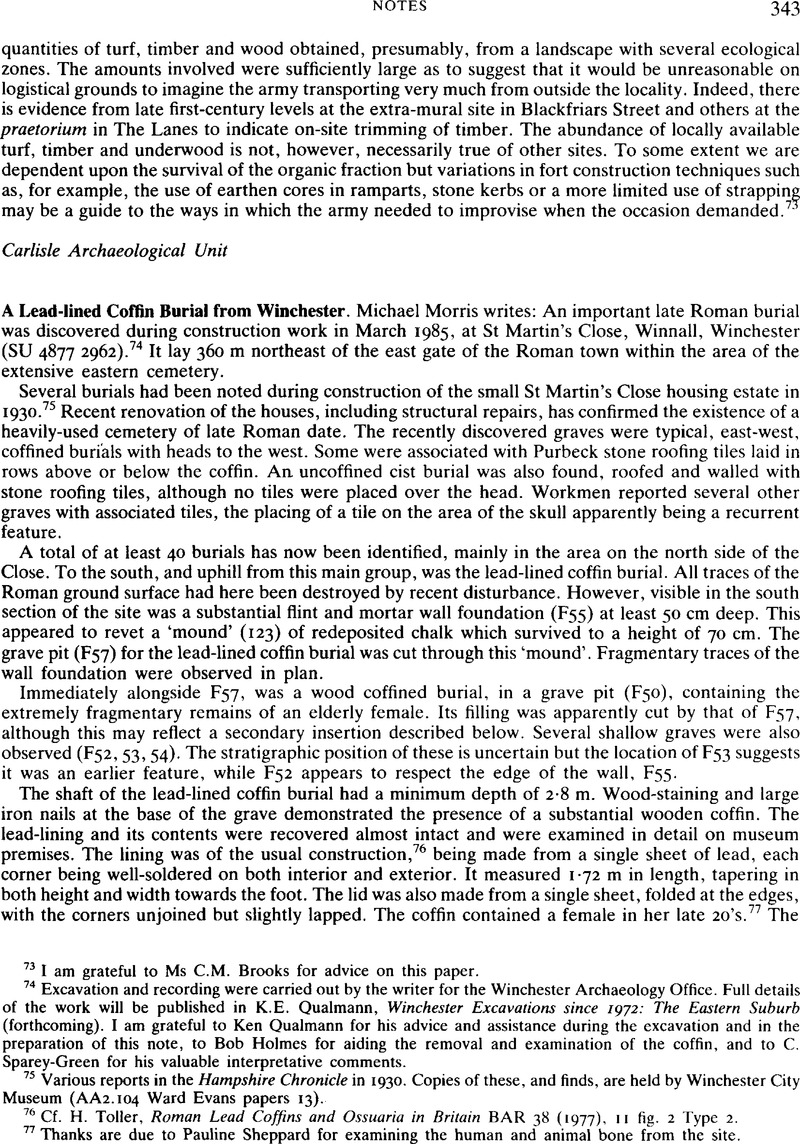Article contents
A Lead-lined Coffin Burial from Winchester
Published online by Cambridge University Press: 09 November 2011
Abstract

- Type
- Notes
- Information
- Copyright
- Copyright © Michael Morris 1986. Exclusive Licence to Publish: The Society for the Promotion of Roman Studies
References
73 I am grateful to Ms C M . Brooks for advice on this paper.
74 Excavation and recording were carried out by t he writer for t he Winchester Archaeology Office. Full details of the work will be published in K.E. Qualmann, Winchester Excavations since 1972: The Eastern Suburb (forthcoming). I am grateful to Ken Qualmann for his advice and assistance during the excavation and in the preparation of this note, to Bob Holmes for aiding the removal and examination of the coffin, and to C. Sparey-Green for his valuable interpretative comments.
75 Various reports in the Hampshire Chronicle in 1930. Copies of these, and finds, are held by Winchester City Museum (AA2.104 Ward Evans papers 13).
77 Thanks are due to Pauline Sheppard for examining the human and animal bone from the site.
78 Galloway, P. in Clarke, G., The Roman Cemetery at Lankhills, Winchester Studies 3 Part ii (1979), 247, fig. 31.Google Scholar
79 Cf. The discussion of the Lankhills Cenotaph by J.L. Macdonald in Clarke (ibid.), 421–3.
80 Cf. Collingwood, R.G. and Richmond, I.A., The Archaeology of Roman Britain (1969), 170–1.Google Scholar
81 Bonded tiles and wall plaster were recovered from the robber trench of the mausoleum at Welwyn (Britannia xv (1984), 145–7).
82 K.E. Qualmann in M. Biddle (ed.), Winchester Studies 4 (forthcoming).
83 A comparable situation has been noted to the south west of Cirencester (Ant Journ. lviii pt. I (1978), 67).
84 Rahtz, P. in Reece, R. (ed.) Burial in the Roman World C.B.A. Res. Rep. 22 (1977), 56–9.Google ScholarCrummy, P. in Rodwell, W. (ed.), Temples Churches and Religion: Recent Research in Roman Britain BAR 77(1) (1980), 265.Google ScholarSparey-Green, C. in Pearce, S.M. (ed.), The Early Church in Western Britain and Ireland BAR 102 (1982), 61–76.Google ScholarBellamy, P.et al., Dorset Nat. Hist, and Arch. Soc. Proc. civ (1982), 190.Google Scholar
85 Bellamy op. cit. (note ) and C. Sparey-Green (pers. comm.). A Christian context has been ascribed to the Poundbury cemetery (Sparey-Green op. cit. (note 84)). Nevertheless, Celtic ritual practice continued throughout the Roman period (Alcock, J.P.Arch. Journ. cxxxvii (1980), 50–85)Google Scholar and it is possible that these cemeteries echo the practice of Celtic cist burial and of the head cult (cf. Cunliffe, B., Iron Age Communities in Britain (1974), 315–6,Google ScholarRoss, A., Pagan Celtic Britain (1974), 94–171.Google Scholar See also Boon, G.C., Silchester (1974), 163, 185).Google Scholar Facial embalming has also been noted in a late Saxon context at Wells (Rodwell, W., The Archaeology of the English Church (1981), 155–6).Google Scholar
- 3
- Cited by


